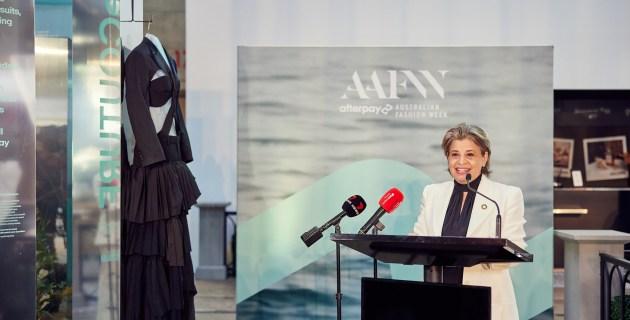In her speech to the industry last week, Australian Fashion Council (AFC) CEO Leila Naja Hibri shared how her team established a clothing circularity roadmap for Australia.
For millennia, First Nations people have been creating clothing with a focus on circular principles. As we move forward on this journey towards clothing circularity, we are committed to learning from the way things have always been done by indigenous creators in this country.
People around Australia are watching us intently, waiting to see what are we going to do about the 1.4 billion units of clothing we import into this country each year, half of which ends up in landfill. I think we can all agree that this is just not acceptable.
This brings us to why we are all here this morning: to launch the National Clothing Product Stewardship Scheme and roadmap to clothing circularity that aims to fundamentally transform the way we design, produce, consume and recirculate clothing.

But before we look to the future, I want to take a moment to tell you about the journey that brought us here. A journey that started back in May 2021, in Canberra, where around 30 passionate fashion and textile sustainability advocates and experts across the clothing value chain gathered in a conference room at Parliament House to discuss the national clothing and textile waste crisis in Australia.
You see, we had just been added to the Minister of Environment’s waste priority list, and we needed to do something about it now. Fast forward to November 2021, and the Australian Fashion Council’s new consortium – with Charitable Recycling Australia, Queensland University of Technology, Sustainable Resource Use and WRAP Asia Pacific – was awarded a grant from the federal government to develop a National Clothing Product Stewardship Scheme, with the aim of creating a circular economy to reduce clothing waste.
And that was it. All we had to do was to design a scheme and a roadmap that will transform the $27.2 billion industry from a linear ‘take, make and dispose’ model to a circular ‘reduce, reuse and recycle’ one in 16 months. Easy, right? Honestly, I don’t know what we expected. What I do know is that when you set out to effect change, systemic and seismic change, things get hard – really hard.
So we worked for countless hours, launching research reports, holding town halls, discussion forums and hundreds of one-on-one meetings. For 16 months, we work closely with a legendary reference group of sustainability experts, the Department of Environment, the Product Stewardship Centre of Excellence, collaborators such as the ARA and the NRA, state and local governments, Woolmark and Cotton Australia, manufacturers, recyclers, designers, brands and retailers, and so many more.
That’s how we did it. We worked together. We dared to challenge the status quo. We talked about the future, to adjust transformation to something better, more prosperous, more progressive, more forward-thinking, a global leader, a circular industry that is respectful of its people and mindful of its planetary boundaries. And for all this, Seamless was born.
Seamless is the name we chose for the National Clothing Product Stewardship Scheme that we are launching. Seamless sets out to bring all the parts of the clothing value chain together in a cohesive and coordinated way, guiding the industry on its journey towards clothing circularity by focusing on four priority areas:
- Incentivising clothing design that is more durable, repairable, sustainable and recyclable.
- Fostering new circular business models based on reuse, repair, remanufacturing and rental.
- Expanding clothing collection and sorting for effective reuse and to ensure non-wearable clothes are recycled into new high-value products and materials, and;
- Encouraging citizen behaviour change for clothing acquisition, use, care and disposal.
A circular clothing industry in Australia by 2030 is one where responsible stewardship and citizenship are embedded across the product lifecycle – from clothing design, and production through to consumption and recirculation. Seamless recognises that brands are responsible for a garment’s entire lifecycle – from design to end-of-life – and will therefore be funded by financial contribution, paid by those brands on each item of new clothing they place on the market.
By launching Seamless now, we will be on our way to delivering a circular clothing economy in Australia by 2030. To achieve this significant transformation, it will require courage, it will require creativity, but most of all it will require collaboration.
In fact, the brands and retailers that have joined Seamless as foundation members are setting a new standard that exemplifies creativity, courage and collaboration. And to those brands I say: thank you for your daring leadership and foresight.
